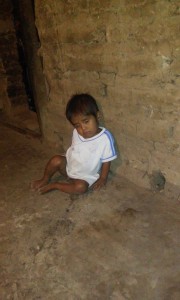 Alicia was rushed from La Concordia only to die in Ayutla.
Alicia was rushed from La Concordia only to die in Ayutla.
Her small town has neither medicine nor doctors, so her parents took her to the nearest hospital–in Ayutla, Guerrero–after three weeks of a fever that would not break. In La Concordia, children routinely die of tuberculosis, like Alicia, and of measles, diarrhea and other illnesses that have long since ceased to claim lives in most societies.
The community health center closes at three o’clock on Fridays. The doctor and nurse leave the community on the weekends. Respiratory and gastrointestinal diseases are common in La Concordia.
On Nov. 22, Minerva took her daughter to the hospital in Ayutla. Without being able to speak Spanish, and with no translator available, she checked her daughter in to be treated. The medical staff told the distraught mother it would be impossible to save her little girl’s life. Alicia died just hours later.
That same day another worry began to creep in—Minerva now needed one thousand two hundred pesos to return to La Concordia and pay for the funeral.
La Concordia, an indigenous ñuu savi town, lacks virtually all basic necessities: medicine, potable water, transit, phone service, food. The inhabitants must make the trek down to Ayutla to buy their basic needs. They leave at five in the morning and come back at two in the afternoon. Those are the only times they can get a ride on the trucks that go down to the plaza.
“It has been two months since the Chikungunya contingency ended. We ran out of aspirin, but they still won’t provide us with more. We don’t have any medicine,” said nurse Luis Antonio, who attends to at least five other communities besides La Concordia.
He adds, “What we need most is medicine. People come in, but we don’t have any medicine to offer them or supplies to treat them with.”
Persecution takes many forms
In the indigenous region of Ayutla de los Libres, persecution against community leaders has intensified since 1998. On April 15, 1998 and July 11, 2001, fourteen Me’phaa (Tlapaneco, in Spanish) men from El Camalote were sterilized by an itinerant health brigade. Run by the doctor on duty, Ernesto Guzmán León, the medical outreach worker Rafael Almazán Solis, and the nurse, Mayra Ramos Benito, they promised the men government aid such as a clinic and a doctor for the community, medicine, groceries, clo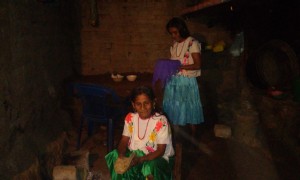 thes, blankets, stipends and grants for those who accepted being sterilized.
thes, blankets, stipends and grants for those who accepted being sterilized.
This is not the only case. The Center for Human Rights of the Mountain Tlachinollan documented similar cases in the communities of La Fátima, Ojo de Agua, and Ocotlán. In the municipality of Ayutla de los Libres, another sixteen indigenous Na Savi men (Mixteco, in Spanish) were coerced into receiving vasectomies using similar bribes and promises.
In the community of El Charco, on the July 7, 1998, soldiers from the 48th Infantry Battalion murdered ten Na Savi natives and one student from the National Autonomous University of Mexico (UNAM), including several leaders and police commissioners from the community. The soldiers claimed that those who attended the community school were members of an armed group.
Since the El Charco massacre, more than twenty indigenous community leaders have been murdered, three have been imprisoned, and thirty sterilized.
In February and March of 2002, soldiers in the 41st Infantry Battalion raped two native Me’phaa women–Inés Fernandez Barranca Bejuco and Valentina Rosendo Cantú–in their community of Barranca Tecuani. Their cases went all the way to the Inter-American Court of Human Rights, which confirmed the crime and called for justice and reparations.
On Feb. 13, 2009, Raúl Lucas Lucía and Manuel Ponce Rosas were abducted by three men armed with assault rifles identifying themselves as “police.” Their bodies appeared eight days later with evidence that they had been tortured before they were executed.
Another community leader, Raúl Hernández Abundio, was arrested during a police operation by the Federal Investigation Agency on April 17, 2008 and imprisoned in the Ayutla municipal jail.
Soldiers of the 48th Infantry Battalion arrested Bernardino García on Aug. 20, 2013. Two months later, Arturo Campos was also apprehended in Chilpancingo. Both were founders of the La Concordia Community Police force, an autonomous community security force. They had complied with the all necessary requirements set forth by the Regional Coordinator of Community Authorities in the regional assembly of La Concordia, the civilian organization and justice system that oversees the force.
La Concordia held a regional assembly to create the community police force on Dec. 20, 2012. Heladio Pedro Morales says that since the establishment of the community police, public safety has been restored in the region. He notes that before, the region was occupied by the Mexican military, which made weekly rounds through the communities, but that despite the military patrols, murders and assaults were frequently committed in broad daylight.
Since the arrests of Garcia and Campos, the military no longer routinely patrols the area. “But we’re better off because now there is a security force that we implemented ourselves,” Pedro Morales says with a smile, as he gestures towards the village.
The road to La Concordia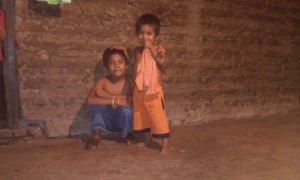
There is only one way to get to La Concordia in the municipality of Ayutla de los Libres, and that’s on the one road that they have. The trip from where the road begins to El Paraíso takes an hour, and from there you have to take a dirt road. If you’re lucky, you can catch a ride in a truck, but if going by foot, the trip takes two hours.
In Ayutla there are local drivers who offer rides at 800 pesos a trip. The farmers sometimes pool resources to pay the fare. Sometimes they have to stand by watching and waiting, because they have to go down the mountain to sell or exchange their products for necessary goods, but they can’t always make the fare.
Ayutla has a population of 997 people; 473 men and 524 women. Only about a third of the inhabitants went to school. Two hundred and forty-nine have had no schooling whatsoever; 219 completed some grades, and 28 have primary-level formal education. The health center in La Concordia serves five other towns: El Coyul, El Coquillo, La Palma, San Felipe, and El Mesón.
When a resident gets sick, he or she has walk between one and two hours to get to a clinic. If the doctor isn’t there, they must continue on to Ayutla. Often patients are simply given a prescription to buy medicine. They typically have to spend between two hundred and one thousand pesos on the trip, not including the cost of medicine.
“There is nothing here. You can die from one day to the next because there is no medicine or doctor,” says Heladio Pedro Morales as he sips a soda.
The residents survive off of agriculture, harvesting corn, beans and sugar cane. These crops are the primary sources of income for most families.
Morales adds, “Here we make our own living. If it weren’t for the cane fields and the beans, I think we would have already died of hunger. We earn a little bit of money selling sugar in Ayutla, but the price is really low so what we earn is a joke.”
“Here we have nothing”
Seated at the only table in the municipal police station of El Coquillo, the police commissioner, Elpidio Castro, speaks with the reporter in his native tongue. Castro never went to school to learn to read or write.
“The only new construction project was the police station in 2004. Since then we haven’t had anything. Here there is no support from the municipal, state, or federal governments. We’re abandoned here–they clear the dirt road every year, but that’s it,” he says as he stacks papers on his desk.
The only way to get to El Coquillo is to walk. It’s two hours on foot from La Concordia to El Coquillo, first through the abundant cane fields that line the path, then winding snakelike up through the foothills. On the sides of the valley, bean and corn fields grow; near the entrance of the community it smells of pine, and dense forest covers the path in shade.
In El Coquillo there are two professors who teach forty-seven children of all ages. The children arrive barefoot, in a worn-out uniform that they’ll wear every day for the entire school year.
The residents of El Coquillo have to go to La Concordia when they get sick. Depending on their luck, they might have to continue on to Ayutla from there. When they go to sell their harvest in town they have to leave home at two in the morning to get a ride to the county seat.
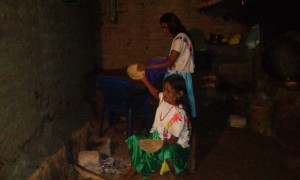 “We are peaceful here, we don’t need community police, and anyway, we don’t have enough to cover the costs. We already are so few, and we are divided into religious committees, school committees, and church duties,” the police commissioner says.
“We are peaceful here, we don’t need community police, and anyway, we don’t have enough to cover the costs. We already are so few, and we are divided into religious committees, school committees, and church duties,” the police commissioner says.
Here women only participate in the health committee organized by the federal charity program, Prospera. Women are excluded from participating in community decision-making. The age for marriage can be as young as fifteen, if a woman’s hand is asked for.
The youngest mother in El Coquillo is 16 years old and has a daughter. She and her husband are teen parents who married at a very young age.
“We have nothing here. There’s none of the food kitchens that the National Crusade against Hunger sets up–those are only in La Concordia. As you see, there’s no public transportation, let alone phone service, clean water, or a health center. We have two little stores that barely sell the necessities,” says the secretary of the commissary, Ignacio Juárez de los Santos, who is also our interpreter for the police commissioner.
Tuberculosis, the disease of abject poverty
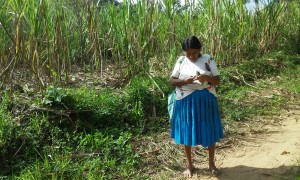 María Luisa walks through the sugarfields gathering greens to cook for dinner. While she’s making her rounds, she stops to talk with this reporter in the native language they share. Nearby the song of crowing roosters and barking dogs gives life to the town of El Coyul, which has barely 200 residents. Between the shacks, the police station, the school, and the church can be seen.
María Luisa walks through the sugarfields gathering greens to cook for dinner. While she’s making her rounds, she stops to talk with this reporter in the native language they share. Nearby the song of crowing roosters and barking dogs gives life to the town of El Coyul, which has barely 200 residents. Between the shacks, the police station, the school, and the church can be seen.
In this community two women came down with tuberculosis two years ago, but they did not receive proper treatment. In the Ayutla hospital they told María Laureana de la Cruz that they didn’t have medicine, and they gave her a prescription to take to the pharmacy the next time she made the trek down to sell her beans and raw cane sugar in town.
María Luisa says that she takes care of her goats every day because they are the only thing that her family has that is of any worth, besides several hens and pigs. She turns to look at the cane and smiles, “Soon we’ll have work because it will be time to gind the cane. In a week, we’ll be making cane sugar we can sell.”
After speaking with her, we arrived at the home of Patricio Gaudencio Porfirio and we sat down to talk to him. When we mentioned medicines and doctors, a bitter smile stretched across his face and he asked the reporter to make sure that others know that in his village people get sick because there are neither doctors nor medicine.
“How do they travel to Ayutla during the rainy season?” I asked him in tu’un savi (Mixteco).
“Well, when it rains we stay in the house. Here it’s easy to die of sickness because there’s no transportation. A lot of times, the drivers don’t make the trip because the road gets really bad,” he answers in a worried tone.
María Laureana joins in on the conversation, and between coughing, tries to say that she is not the only one who has this rare disease. “Cándida Marcelina Sabino has the same cough. We went to the doctor, but they told us that we were fine even though my son’s school teacher says I have tuberculosis. Sometimes I have a fever and a headache, but with home remedies I can usually get rid of them.”
She had not yet finished her explanation of her home remedy when Patricio began speaking again. He complained of how the president of the municipality, Severo Castro Godínez, wanted to pave the road between Ayutla and La Concordia. “They started to work on the road during the rainy season, but everything they did during the day was swept away at night by the rain, and so there they were, and they never did finish paving the road,” he explained.
*********
Minerva Emiliano Porfirio looks at the photo of her six year-old daughter, Alicia, who died from tuberculosis. “My daughter… poverty is what killed my daughter. We didn’t have money to pay for treatment and in the health center they said they didn’t have any medicine. She got much worse on Sunday so we took her to Ayutla, but it was useless—we just brought her there to die,” she says with a choked voice._
In Minerva’s house the only thing that thrives is hardship.
______________________________________
“Poverty is what killed my daughter,” Minerva Emiliano Porfirio, mother of Alicia, aged 6.
______________________________________
Alicia’s younger siblings all have the distended stomachs that signal child malnutrition. They are barefoot, and they don’t even have woven bed mats to sleep on.
Here the effects of poverty cut deep. This becomes even more apparent upon listening to what Minerva’s husband, Cristino García Ceferino, has to say.
“We sold the beans and corn on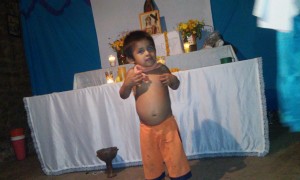 time, so when it comes time for the harvest we give over everything we have because we owe lots of money. I had to sell my horses and cows. We live in miserable conditions,” he says.
time, so when it comes time for the harvest we give over everything we have because we owe lots of money. I had to sell my horses and cows. We live in miserable conditions,” he says.
Before her daughter gets forgotten in the conversation, Minerva speaks up again. She says that she herself got sick and they went to Acapulco where she was admitted and held in the hospital for ten days. At this point, Minerva runs to her room and returns several minutes later with a sheet of paper in hand. It is her medical discharge report from the hospital.
In the document it says that Minerva checked into the hospital because of a septic miscarriage and that she was also diagnosed as likely having type-two diabetes. “We spent so much money there, nearly 18 thousand pesos. My husband sold everything we had,” she says sadly.
She adds, “Because of that, we didn’t know what to do when my daughter got so sick. I sold my chickens so I could scrape together the 1000 pesos to pay a driver to take us, but my daughter couldn’t hold on. She died the same night we checked her in. Afterwards, we had to find someone who would be able to help us with the 1,200 pesos to bring her body back.
Cristino and Minerva sold everything, even the house and the land. They now live with Cristino’s brother in a house with dirt floors and no plumbing. In their tiny home they lack all basic necessities, and they now must set to work to pay off the nearly 30 thousand pesos they borrowed for Minerva’s medical bills and Alicia’s funeral.
Kau Sirenio Pioquinto, (Cuanacaxtitlán, Guerrero), is an indigenous ñuu savi reporter. He was a reporter for El Sur de Acapulco and La Jornada Guerrero and a radio host for the bilingual program Tatyi Savi (Voice of the Rain) for Radio and Television Guerrero, and for Radio Autonomous University of Guerrero XEUAG in the tu’un savi language. He works as a reporter for the weekly newspaper, Trinchera and is a regular contributor to the Americas Updater of the Americas Program. www.americas.org
Translation by Allana Noyes
Editor: Laura Carlsen



